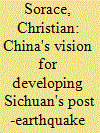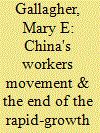| Srl | Item |
| 1 |
ID:
132953


|
|
|
|
|
| Publication |
2014.
|
| Summary/Abstract |
In the aftermath of the 2008 Wenchuan earthquake, government officials, scholars and outside observers eagerly hoped that the emergency relief and reconstruction process would bring about the emergence of civil society and increase grassroots democratic participation. Contrary to this optimistic assessment, this article contends that the local state used the opportunity of the disaster as an experimental laboratory to implement an array of already existing national development plans. The urgency with which the reconstruction was to be completed and the opportunities to meet national development targets as well as access reconstruction funds were too tempting to resist. However, the ham-fisted Leninist implementation style met with local resistance and has contributed to a significant deterioration in local state-society relations. The fact that many local residents continue to question why, despite the huge resources invested by the state in the reconstruction project, they have yet to see any improvement in their economic and overall living conditions points to a deficit of local participation and a breakdown in political communication and trust. By focusing on the different political economies of disaster reconstruction, this article attempts to illuminate the regime's vision for developing the countryside, rural politics, and state-society relations in China more broadly. Unless the state is able to incorporate local needs into its development plans, it will not win the trust and support of local residents, regardless of the amount of money it invests or the benevolence of its intentions.
|
|
|
|
|
|
|
|
|
|
|
|
|
|
|
|
| 2 |
ID:
130404


|
|
|
|
|
| Publication |
2014.
|
| Summary/Abstract |
China's rapid economic growth period was predicated on a development model that exploited the stark divide between its urban and rural citizens. As the workshop of the world, Chinese factories tapped the vast surplus labor of the countryside. Rural workers' expectations were low, but their desire for new employment opportunities was boundless and their numbers seemed limitless. Three decades later, these conditions have changed: workers' expectations are higher and their numbers are diminishing as the population ages. Labor disputes and strikes are endemic as the expectations and aspirations of workers outpace the nation's slowing growth rate. Compared to the anemic labor movements in the West, China's workers are emboldened, though they are still hampered by a repressive political environment and strict constraints on freedom of association. Conflict is spontaneous and settlement is ad-hoc. Like many authoritarian regimes, the Chinese Communist Party has difficulty committing to the institutionalization of labor conflict as it heightens the possibility of social empowerment. The state remains in charge, which also means that labor-capital conflict almost invariably metastasizes into a confrontation between workers and the state.
|
|
|
|
|
|
|
|
|
|
|
|
|
|
|
|